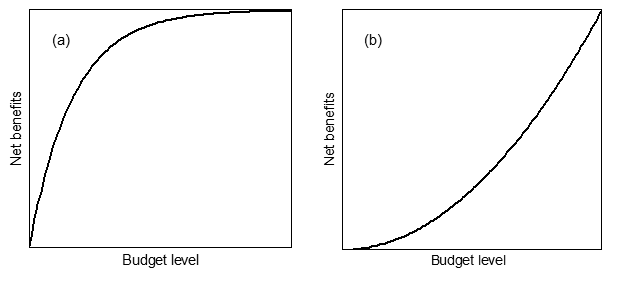184 – The optimal scale of environmental projects
In the last two Pannell Discussions, I’ve talked about the relationship between the scale of environmental projects and their costs (PD182) and benefits (PD183). This time, I’ll further tease out the implications for the optimal scale of environmental projects.
I’ve identified three reasons why there could be diminishing marginal net benefits as project scale increases, like Figure 1(a).
(i) Increasing marginal costs. These are likely to apply to almost every project.
(ii) Decreasing marginal benefits due to the relationship between inputs and environmental outcomes. These occur in at least some cases. In others, the relationship is roughly linear, and in others still, there may be scale thresholds, such that benefits increase greatly above a certain project size, resulting in increasing marginal benefits, like Figure 1(b).
(iii) Decreasing marginal benefits due to the relationship between environmental outcomes and the psychological benefits that people experience. These are likely to apply to almost every project.

Figure 1. (a) Decreasing marginal net benefits and (b) increasing marginal net benefits from environmental projects.
Considering the influence of all three factors, it seems likely that Figure 1(a) would be the relevant one for most environmental projects. The exceptions would be projects for which increasing marginal benefits due to scale thresholds are so extreme that they outweigh the other two factors, (i) and (iii). Personally, I doubt that there would be many projects in that category, but there might be some.
Implications for environmental programs
Diminishing marginal net benefits tends to mean that smaller projects are better in aggregate than larger projects.
Note that this is not an argument for a proliferation of really tiny projects. Projects, whatever their scale, need to be funded to a high enough level and for long enough so that they will really achieve and sustain the intended environmental outcomes. That has often not happened in past programs, with many projects funded at too low a level, for too short a time.
Another reason not to fund thousands of tiny projects is that there is enormous heterogeneity among projects. The net benefits of a public environmental investment are sensitive to many factors, including: the value of the environmental assets; the degree of environmental degradation the assets face; the technical feasibility of avoiding or reversing that degradation; the costs to landholders of adopting the environmental practices; the skills, knowledge and interests of local landholders; and the likelihood of receiving required cooperation from other agencies and organisations. Each of these factors is likely to be highly variable from region to region, from state to state, and from issue to issue. This means that some projects will have much higher benefits per dollar invested than others, providing a very strong reason for identifying and funding the best projects in a targeted way, rather than funding every proposed project at a low level.
Pulling all this together, it is usually not optimal to concentrate the environmental budget onto a small number of huge projects that attempt to treat the whole landscape in a region, because of diminishing marginal net benefits, particularly due to reasons (i) and (iii) above.
On the other hand, it is also not optimal to spread the budget widely over many, many small projects, because of the huge range of payoffs between projects, which means that the best of those projects are much better than the rest, and because most projects require reasonably substantial budgets to achieve sustained, worthwhile outcomes.
Therefore, in my judgment, the best general strategy is to go for well-targeted, moderate-sized projects, and to fund them well. For example, such a project might undertake carefully selected works to improve a particular environmental asset – a group of wetlands, say – rather that trying to improve the whole region.
Although I’ve referred to these projects as “moderate-sized” in a spatial sense, in many cases their budgets should be quite a lot bigger than is typical in Australian government programs. Well designed, outcome-oriented projects would often be considered “large” from a budget perspective, relative to many existing projects.
David Pannell, The University of Western Australia